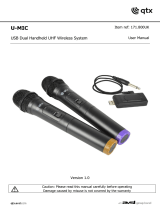SA180 User Manual
Operation
When all connections to the amplifier are made, turn all rotary controls down and switch on the power (17)
and a power “ON” LED will illuminate.
Turn BASS and TREBLE controls (3, 12) to the 12 o’clock position (pointing straight up) and turn the MASTER
volume control (13) up part way for testing.
The SA180 is supplied with a built-in UHF wireless microphone. Install 2 x alkaline AA batteries by unscrewing
the bottom of the housing and inserting the batteries with the base of each onto the spring, as indicated
inside the compartment. Screw the bottom housing back in place and extend the UHF antenna on the SA180
front panel (do not close the cabinet door whilst the antenna is extended)
Slide the switch on the handheld microphone fully up (2 notches). Increase the UHF MICROPHONE volume
control gradually whilst speaking into the handheld microphone until the voice can be heard through the
speakers and increase to the required level. Sliding the microphone switch back to the centre position leaves it
powered on but temporarily muted. Sliding the switch all the way down switches the microphone power off.
For wired microphones connected to INPUT 1 or INPUT 2, gradually increase the volume control for that input
channel whilst speaking into the microphone until the voice is heard through the speakers.
The internal UHF wireless microphone or connected wired microphones should not be able to “hear” the
speakers, which can cause feedback (squealing or howling). Ensure that microphones are pointed away from
speakers and reduce the volume of any which are causing feedback.
For line inputs, such as a CD player, laptop or TV box, ensure that the audio source is playing and increase
the volume control until it is heard through the speakers. Adjust the volume to the required output level.
Note: If a mic or line input is not connected, the initial test can be made using the built-in media player.
See the “Media player” section for instructions.
Turn up the MASTER volume to the maximum required output level and reduce the various input channel
volume controls if necessary.
The output of the amplifier is represented on the VU meter LEDs (2) and this indication is to help the user to
avoid overloading the amplifier.
In addition to channel and MASTER volume controls, there are BASS and TREBLE EQ controls (7, 8) to adjust
the tone of the overall output. At the 12 o’clock position, these controls apply no effect to the signal (no boost
or cut).
Moving the BASS control clockwise boosts the low frequencies in the audio, whilst moving it anticlockwise will
cut these low frequencies. Likewise, moving the TREBLE control clockwise boosts the high frequencies in the
audio, whilst moving it anticlockwise will cut these high frequencies.
Adjust these EQ controls to suit the type of audio signal or compensate for the room acoustics.
If the level goes above 0dB, the internal limiter will be activated to automatically control the output, helping to
avoid damage to the amplifier or speakers. This should only be for a very short flash at any one time.
If the LIMITER LED flashes consistently or for longer than a brief instant, then the MASTER volume should be
turned down until it is not as continuously active.










